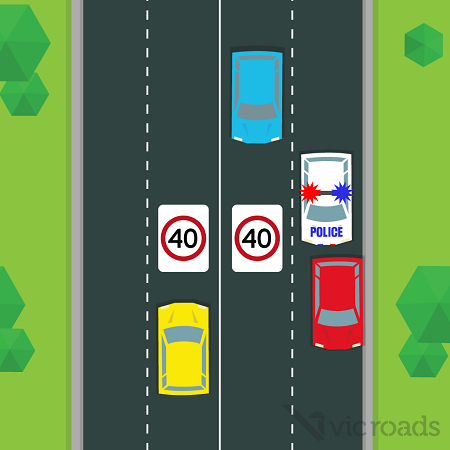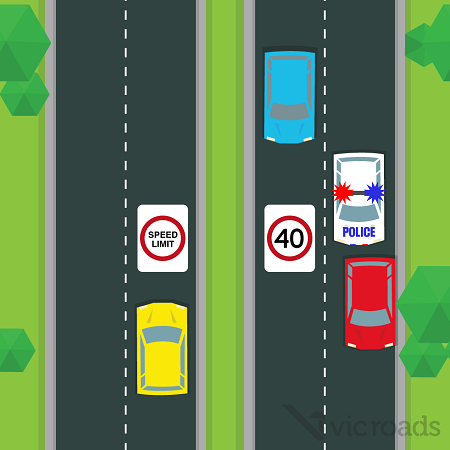Law enforcement & emergency vehicles
This page outlines the road rules around law enforcement and emergency vehicles.
Keeping clear of law enforcement and emergency vehicles
If a police, emergency, enforcement or escort vehicle has its red, blue or magenta lights flashing or its siren on, you must:
- Get out of its way
- Give way and stop if necessary, even if you have a green traffic light.
You must also stop if twin red lights are flashing on a road, e.g. outside a fire or ambulance station. You can start driving again once the lights have stopped flashing and the road is clear of emergency or other vehicles.
In emergencies, law enforcement and other emergency vehicles are not required to follow the road rules.
Passing law enforcement and emergency vehicles
The 40km flashing lights rule was introduced to improve safety for our emergency and enforcement workers.
You must slow down to a speed that would enable you to stop safely when approaching and passing enforcement, emergency or escort vehicles that are stationary or moving slowly (less than 10km/h)*, and have either:
- Red and blue flashing lights
- Magenta (purple flashing lights)
- An alarm sounding.
You must not exceed 40km/h when passing the vehicle and not increase your speed until a safe distance from the scene (more on this below).
The new road rule does not apply to vehicles on the opposite side of a divided road (separated by a median strip) from an emergency or enforcement vehicle scene.
* A fire truck extinguishing roadside spot fires is an example of a slow moving emergency vehicle.
How should I slow down safely to comply with the new road rule on a high speed road?
Show more
If police need to stop a vehicle on a high speed road, they will always try to do this in a location that can easily be seen by approaching drivers so there is enough time to slow down safely.
If an emergency or enforcement vehicle is in an area of low visibility due to the location or poor weather, it will be because it is absolutely necessary and there will likely be alarms sounding in addition to flashing lights.
In these situations, drivers should slow down safely when they first see flashing lights, taking into account the current road conditions and avoiding sudden braking.
Reducing speed, even if the vehicle does not get down to 40km/h, will still have safety benefits for law enforcement or emergency workers and will help drivers take evasive action if needed.
Is the new rule consistent with other safety speed restrictions?
Yes, the new rule is consistent with existing speed restrictions through:
- School zones
- Work zones
- Environments with vulnerable and unprotected road users.
What is considered a safe distance?
Show more
A ‘safe distance’ has not been defined in the road rule because every incident will be different.
For example, a fire truck may be stationed by the roadside with flashing lights but the fire fighters may be managing a fire further up the road. In this instance, drivers should not increase their speed until they are fully past all emergency personnel.
In contrast, a roadside vehicle stopped by Victoria Police will require drivers to slow down and travel at 40km/h for a much shorter distance.
It is the responsibility of all drivers to be aware of the individual circumstances of each roadside incident and to drive accordingly.
When can I return to the posted speed limit?
Show more
The rule requires drivers and riders to slow to 40 km/h when passing stationary enforcement or emergency vehicles with flashing lights. Once fully passed the enforcement or emergency vehicle, the rule requires drivers not to increase speed until a safe enough distance from the roadside incident.
The rule does not designate what is considered a 'safe enough distance' from the incident, as roadside incidents can vary significantly. For example, in most cases, it would be safe to increase speed once immediately passed a police vehicle conducting routine roadside intercept, while a roadside fire incident would likely require you to continue to travel at 40 km/h once passed the fire vehicle, as there may be emergency fire workers performing duties up ahead.
You do not need to wait for the next speed sign to increase your speed back up to the previously posted speed limit.
Does the new rule apply on all road types?
Show more
Yes, it applies to all roads, including freeways.
On roads that are not divided you must slow to 40km/h in both directions.

On roads with a median strip between your vehicle and the emergency or enforcement vehicle you do not need to slow down.

A median strip is the centre area of the road that separates vehicles travelling in opposite directions. Median strips come in all shapes and sizes. A median strip can be covered in grass, it can include or be a wire rope or concrete barrier or be as simple as a continuous painted island.
Examples of median strips



A median strip does not include double white lines, a single white line or a broken white line on its own or in combination with a continuous white line. It also does not include short painted islands typically found as part of intersections turning lanes.
For entrance lanes on freeways you must slow down if the emergency or enforcement vehicle is positioned where the two roads merge.
Do I need to slow down if an emergency or enforcement vehicle is in a service lane?
Show more
Emergencies are not limited to the side of the road and can occur anywhere on the road including dividing strips. As it is not possible to know where an incident is traffic must slow to 40km/h even if the emergency service vehicle is in the service road.
What if the posted speed limit before the scene is already 40km/h?
Show more
If the posted speed limit is already 40 km/h, such as on a managed motorway, then you must not increase your speed above 40 km/h until the posted speed limit changes accordingly, including when you have passed the scene. The new rule does not permit drivers to exceed the speed limit and drivers are always obliged to adhere changed speed limit conditions.
What type of emergency or enforcement vehicles are covered by the new rule?
Show more
- Police vehicles
- Ambulance Victoria vehicles
- Metropolitan Fire Brigade vehicles
- Country Fire Authority vehicles
- Forest Fire Management Victoria vehicles
- State Emergency Service vehicles
- Search and Rescue Services
- The National Heavy Vehicle Regulator (NHVR) Safety and Compliance Officer vehicles (magenta (purple) flashing lights)
- Enforcement vehicles (magenta/purple flashing lights) under the control of a state transport body including VicRoads, DEDJTR and Taxi Commission enforcement vehicles
- Other emergency patient transport vehicles with red and blue flashing lights.
Why is this new rule being introduced?
Show more
Incidents on our roads place first responders and others involved at a high risk of being struck by passing vehicles or debris.
Near misses are common. A recent survey of more than 1,600 emergency service and enforcement workers revealed that in the past three years:
- 17% had a ‘near miss’ involving a passing vehicle on four or more occasions
- 3% had been injured while evading a passing vehicle
- 8% had their vehicle struck by a passing vehicle
- 23% of those involved in an incident had consequential mental health issues.
The new rule means improved safety for emergency and enforcement workers who are performing work on the road or roadside, as well as others who are present at the scene.
40km/h is the maximum speed at which pedestrians are likely to survive vehicle impact.
Why are other special purpose vehicles with different coloured lights not covered?
Show more
The new rule applies to emergency and enforcement vehicles only as it is consistent with existing road rules 78 and 79, which require drivers to move out of the way of an emergency or enforcement vehicle with flashing lights or sounding an alarm.
The rule doesn’t apply to special purpose vehicles with yellow flashing lights.
Yellow flashing lights warn drivers of a road hazard up ahead such as road works, the presence of a tow truck operator or another first responder. Upon seeing yellow flashing lights, drivers should continue to drive in a safe manner, observing any traffic control measures in place and avoid endangering the welfare of other road users.
Can I be fined for not obeying the new road rule?
Show more
Yes, you can be fined but no demerit points will apply.
The infringement penalty for breaching the new road rule is 1.75 penalty units ($272.05), with the maximum court penalty of 5 penalty units ($777.30).
Victoria Police has also advised that its primary goal is to educate the community about safe speeds around incidents to prevent the death or serious injury of workers and others at the scene.
Don’t motorists already slow down if they see an emergency vehicle ahead?
Show more
Most people already slow down when they see an emergency vehicle ahead with red and blue flashing lights, and/or alarm sounding.
The new rule establishes a required standard for safe behaviour and further ensures emergency workers can get on with their important work without worrying about being struck by a passing vehicle or debris.
The rule has been designed to provide maximum safety benefits to emergency and enforcement workers while keeping it simple for the Victorian community to understand.